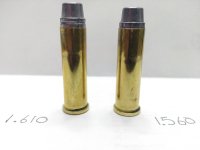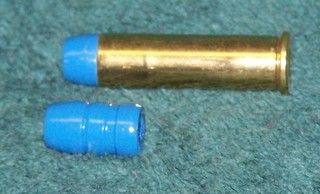National86,
You got confused. 1.610" is the SAAMI maximum COL for
44 Magnum, not 357 Magnum. 1.590" is the SAAMI maximum COL for
357 Magnum. 1.405" is the minimum COL given in the SAAMI drawing I linked to. You are only 0.030" below maximum. However, it appears from your image that you are not enough lower. You want the front (top) edge of the crimp groove to be just above the case mouth so that the crimp folds into the groove. That's what it is for.
If you don't crimp a revolver load, recoil drives the cylinder back against the case rims of the remaining cartridges in the cylinder abruptly, while inertia tries to hold the bullet where it is. The result is the gun and cases pull back from the remaining bullets a little more with each shot, leaving them sticking out too far. This can jam cylinder rotation. Lubricated lead bullets are particularly vulnerable to it, though with a light enough load and a heavy enough gun, the effect is minimized and may not be an issue. Still, you'll get more consistent performance from a well crimped load.
The reason pressure is not an issue is two-fold. One is that your load isn't very high, as already mentioned. The other is that you are using a blunt shaped bullet, which is short for its weight compared with, say, a round nose bullet. The powder has no idea where the tip of the bullet is, so it doesn't care about that. What affects the powder and pressure are the weight and hardness of the bullet and the amount of space the powder starts burning in. The latter is controlled by the distance from the inside bottom of the case to the bottom of the bullet. That's what matters. So, if a COL of one loading is 0.1" shorter than another, but the bullet is the same weight and hardness and is also 0.1" shorter in the first load, then the pressure is the same.
The usual way the size of the space is determined is by seating depth. Seating depth is:
Seating Depth = Case Length + Bullet Length – Cartridge Overall Length (COL)
If you have an established seating depth you can seat different bullet lengths to that same seating depth by adjusting their COL, where the bullet configuration allows. This is done by rearranging the above formula to solve the COL:
COL = Case Length + Bullet Length – Seating Depth
(Note that hardness needs to change a lot to matter. All cast and swaged bullets (BHN 5-30 with most between 9 and 18) are treated the same from this standpoint, while jacketed bullets (BHN 40) are the next harder step, and solid copper or brass or bronze bullets (BHN's up to 90 or so) are the next harder step after that.)
One of the confusing things about the SAAMI specs for the layman is that the dimensions are unilateral. This is a common engineering practice where an error in one direction is more consequential than in the other. We are all used to tolerances that are plus or minus some amount, which are used where the direction of the error has equal consequence. But in the case of, say, sizing a shaft for a sleeve bearing, making the shaft too small still lets you assemble and operate the machine even if it doesn't work or last well. But make the shaft too big, and you can't even assemble it, so too big is considered a more consequential error. To avoid that, the shaft diameter is given as its maximum critical not-to-exceed value, followed by a minus-only tolerance to set the minimum recommended size. The sleeve bearing is just the opposite, and the value its diameter is given on a drawing is its minimum critical size, followed by a plus-only tolerance to set the recommended maximum looseness of fit.
In cartridges and chambers, SAAMI does the same thing as the shaft and bearing. A cartridge that is too big won't chamber, or a chamber that is too small won't allow a correct size cartridge to chamber. So cartridge lengths and diameters are given as their critical maximum values with a minus tolerance, while chamber lengths and diameters are given at their critical minimum values with a plus tolerance for the maximum size range. Thus, when you see a value in load manual for a cartridge length, that is a not-to-exceed. The manuals seldom include the minus tolerance. Too many people read that as meaning they should subtract that number from the given number, so it causes confusion as they don't understand it is giving them a range. They could do the subtraction and provide it as minimum and maximum, but they don't do that either. So it causes confusion.
Another thing to be aware of is that the SAAMI maximum cartridge overall length is there to insure fit in magazines and cylinders. If your gun has extra room and you have a bullet you can seat out further to make more powder capacity, that's fine and you can use it if you have a bullet that can be seated out that far and still allows you to crimp.


